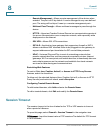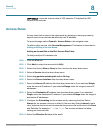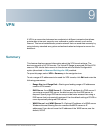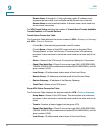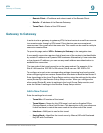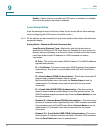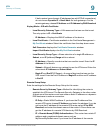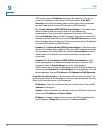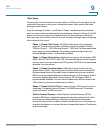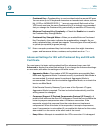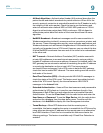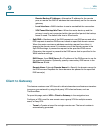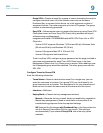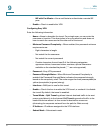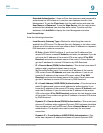
VPN
Gateway to Gateway
86 Cisco RV320/RV325 Administration Guide
9
VPN router, choose IP Address, and enter the address. If you do not
know the IP address of the remote VPN router, select IP by DNS
Resolved, and enter the domain name of the router. Cisco routers can
get the IP address of remote VPN device by DNS Resolved.
- IP + E-mail Address (USER FQDN) Authentication—This router has a
static IP address and you want to use an E-mail address for
authentication. If you know the IP address of the remote VPN router,
choose IP Address, and enter the IP address. If you do not know the IP
address of the remote VPN router, select IP by DNS Resolved, and enter
the real domain name of the router. Cisco routers can get the IP address
of remote VPN device by DNS Resolved.
- Dynamic IP + Domain Name (FQDN) Authentication—This router has a
dynamic IP address and a registered Dynamic DNS hostname (available
from providers such as DynDNS.com). Enter a Domain Name to use for
authentication. The domain name can be used only for one tunnel
connection.
- Dynamic IP + E-mail Address (USER FQDN) Authentication—This
router has a dynamic IP address and does not have a Dynamic DNS
hostname. Enter an Email Address to use for authentication.
If both routers have dynamic IP addresses (as with PPPoE connections),
do not choose Dynamic IP + Email Address for both gateways. For the
remote gateway, choose IP Address or IP Address by DNS Resolved.
• Local Security Group Type—LAN resources that can use this tunnel. The
Local Security Group is for this router’s LAN resources; the Remote Security
Group is for the other router’s LAN resources.
- IP Address—Specify one device that can use this tunnel. Enter the IP
Address of the device.
- Subnet—Allow all devices on a subnet to use the VPN tunnel. Enter the
subnetwork IP Address and Subnet Mask.
- IP Range—A range of devices that can use the VPN tunnel. Enter the
first IP address in Begin IP and the end IP address in End IP.



